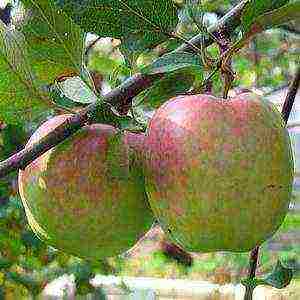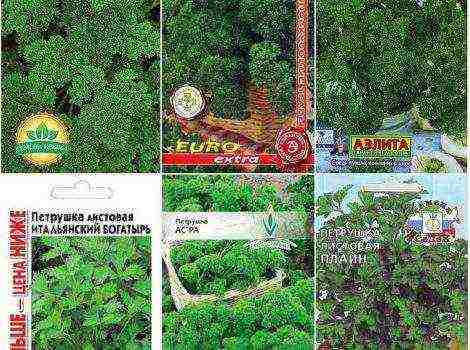Content
- 1 Cherry varieties: description and photo
- 2 The best early varieties of cherries
- 3 The best mid-season cherry varieties
- 4 The best late varieties of cherries
- 5 The best self-fertile varieties for the Moscow region and the middle lane
- 6 Early winter-hardy and late cherry varieties
- 7 Yellow cherries that are not afraid of birds
- 8 Low-growing trees - small, but remote
- 9 Backyard yellow
- 10 Bereket
- 11 Goryanka
- 12 Tyutchevka
- 13 Dunn
- 14 Dolores
- 15 Pridonskaya
- 16 Tree height
- 17 Frost resistance
- 18 Pollination
- 19 Berry ripening time
- 20 Berry color
- 21 Fruit shape and weight
- 22 Choosing a fruitful cherry variety for the Moscow region
- 23 The sweetest and most delicious options according to the estimates of experienced gardeners in Russia
- 24 The largest-fruited trees, their characteristics
- 25 Highest yielding varieties in alphabetical order

Let's talk about cherries and describe the best varieties of it. There are sweet, slightly sour, crispy, soft, different colors. Thanks to selection, every year new forms of this amazing tree are bred.
Cherry varieties: description and photo

To get a bountiful harvest, it is necessary to choose varieties taking into account the peculiarities of the climate in a particular region. So, frost-resistant varieties are suitable for central Russia, and more thermophilic plants can be grown in Ukraine.
Unlike cherry, sweet cherry ripens much earlier, its tasty and aromatic fruits can already be enjoyed in early summer - June. It is a real source of useful trace elements (iron, iodine, potassium, magnesium, calcium) The fruits of the plant grow in the form of a single-celled drupe with a juicy pericarp.
Taking into account the late period of emergence of cherry fruit buds from the state of forced dormancy, the yield of this crop is characterized as stable. Another advantage of cherries is the presence of reliable protection from return frost in anthers and pistils, which is not the case with cherries.
The leaves of the fruit crop are very large in size, they are distinguished by an elongated-oval or elongated-obovate shape and brown glands on the petioles.
Most of the cherry varieties require additional pollination. Therefore, when choosing a tree, it is recommended to study its description, which indicates the necessary pollinators.
It is not so often possible to find self-fertile varieties on the market. They can be purchased by order from abroad. Among the popular hybrid forms, there are: Alex, Peter, Stella, Sandor, Sweet Hart.
Below is a list of the most popular cherry varieties with descriptions and photos.
Iput
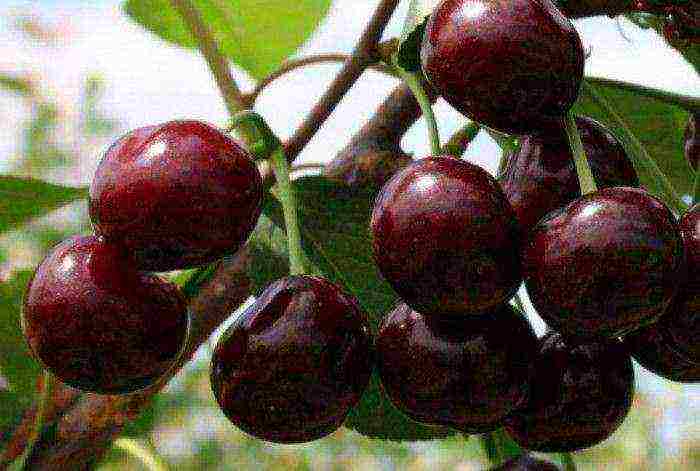
Read also:Everything about planting and growing cherries - from choosing a seedling to harvesting (Photo & Video) + Reviews
PROS:
- Average height
- Early ripening of fruits
- High yield (up to 30 kg of berries are removed from one tree)
- High palatability (fruits have black color and dark red juicy pulp)
- The berry is removed with the stalk
- The crop is not afraid of transportation
- High degree of resistance to fungal infections
- It tolerates low temperatures well (up to -28 degrees)
MINUSES:
- Average early maturity (yields a harvest 5 years after planting)
- With an excess of moisture, the fruits crack
- The pulp is difficult to separate from the bone
According to reviews:
It is recommended to plant it in pairs together with Revna, since these varieties are inter-pollinated. It turned out to be very tasty, large, the first harvest is already 3 years old. It grows quickly, almost one-meter increments per year. turned out to be not dark red, but just red, maybe because of the lack of the sun.
Valery Chkalov
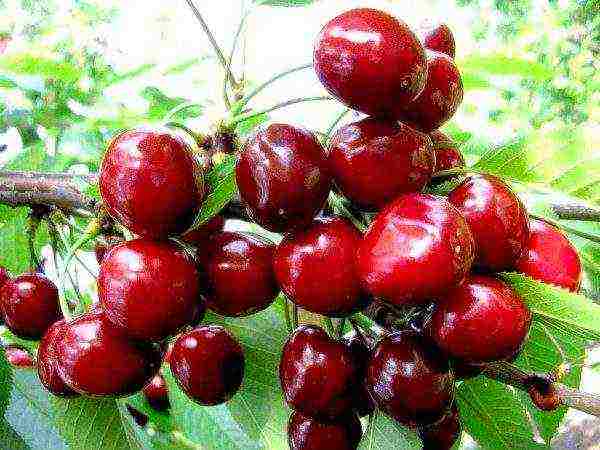
PROS:
- Early ripening of berries
- Large fruit size (weight up to 6-8 g)
- High taste characteristics of fruits (the pulp is dark red in color, juicy, semi-gristly consistency)
- Dessert type
- Universal use of berries
- High level of productivity (62 kg per tree on average)
- High level of frost resistance (-23.5 degrees
MINUSES:
- Height (up to 5 m)
- Wet separation of the berry from the stalk, juice is released
- The level of early maturity is medium (yields a harvest for 5 years)
- Self-infertile variety
- Average level of resistance to diseases, including fungal
Pollinators: Dnieper, Bigarro Burlat, April, June early Skorospelka
Jealous
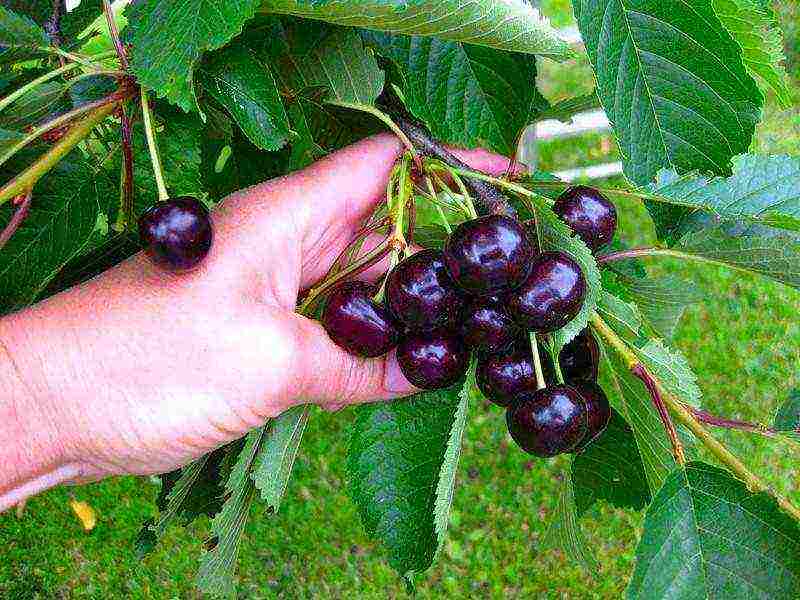
Read also:Cherries: what you need to know about them in order to get generous harvests. Description, planting and care (25 Photos & Videos) + Reviews
PROS:
- Medium-sized tree, compact
- The crown has no sharp forks
- Unpretentious in care
- Fruits are distinguished by high taste and consumer qualities.
- Due to the dense skin, the crop is transportable over long distances
- High level of frost resistance (up to -30 degrees)
- High resistance to frost crack, sunburn
- Resistance of the tree to fungal infections
MINUSES:
- Medium late harvest ripening
- Self-infertility
Its best pollinators: Raditsy, Compact, Iput, Venyaminova, Tyutchevka, Ovstuzhenki
Large-fruited
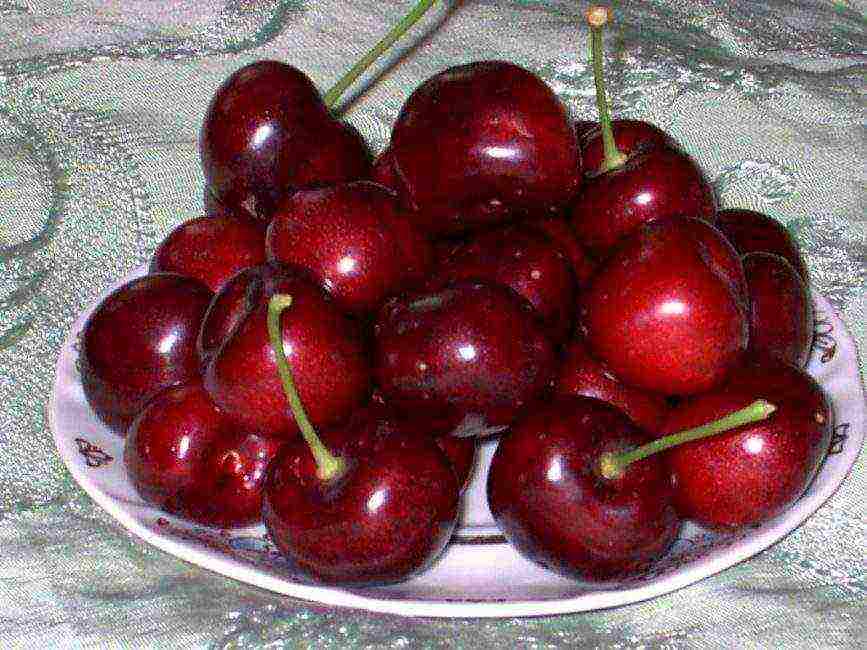
PROS:
- Medium-sized tree
- Fruits are very large in size, their weight is up to 18 g
- Sweet and sour taste, dark red fruit color, medium density pulp
- High product characteristics
- Increased frost resistance
- Dry detachment of the peduncle
- Good transportability
- Not susceptible to moniliosis
- Drought tolerance, no loss of crop flavor
MINUSES:
- Late ripening
- Self-sterile
Top pollinators: Bugaro Oratovsky, Surprise, Francis,
Vasilisa

PROS:
- Mid-season
- Very large berries, weighing up to 15 g
- Taste and commercial qualities are excellent (the fruits have a rich red color, glossy shine, the pulp is dense, fleshy, juicy)
- Tasting score 4.5 points
- Duration of fruiting 20 years
MINUSES:
- Berries with heavy precipitation are subject to shedding
- Requires additional pollination
- Low resistance to fungal diseases and garden pests
Top pollinators: Early ripening, Burlat, April, Household, Early Bigarro
Ovstuzhenka

PROS:
- Early ripening of the crop
- It does not require special care
- Medium-sized tree, with a rapid growth rate
- Large berries, weight up to 7 g
- The pulp is sweet enough, juicy
- The color of the berries is dark burgundy
- Product and taste characteristics are high
- Disease resistance is good
- High frost resistance
MINUSES:
- Average yield, on average 15 kg per tree
Regina
PROS:
- Late-ripening variety
- The size of the tree is medium, the growth is gradual
- Does not create difficulties in care and harvesting
- High indicator of presentation and taste
- Berries are not afraid of transportation
- The structure of the berries is firm, the pulp is tasty and aromatic
- The size of the fruits is large, their weight reaches 10 g
- The level of frost resistance is sufficient
- Disease resistance to garden pests is excellent
MINUSES:
- Low rate of resistance to viral diseases
- Requires additional pollination
Pollinators: Karina, Bianca, Sylvia, Nephris, Coral Lotivka
Bull heart

PROS:
- Large-fruited, average berry size 8 g
- The color of the fruit is dark burgundy, the pulp is of medium density, the skin is moderately dense with a smooth surface
- Type of separation from the stalk dry
- Universal purpose of fruits
- High degree of productivity
- The size of the tree is medium, but there are also tall plants.
- The degree of frost resistance is good, up to - 25 degrees
- Not susceptible to coccomycosis
MINUSES:
- Low transport rate despite dense skin
- Berries have a short shelf life, processing is required as soon as possible
- Self-infertile variety
Top pollinators: Tyutchevka, Iput, Ovstuzhenka
Yellow

PROS:
- Late ripening of berries
- Increased winter hardiness
- Excellent taste (the pulp is amber, dense structure, juiciness and pronounced aroma)
MINUSES:
- The degree of transportability is low
- The pulp does not separate well from the bone
- Additional pollination required
- Exposed to the invasion of the cherry fly
Pollinators: Bagration, Napoleon pink. Denissena yellow, Cassini early
Early pink

PROS:
- Early ripeness of fruits
- Taste characteristics are high (the pulp is distinguished by a creamy color, the structure is medium-dense, the juice is transparent)
- High resistance to low temperatures
- A fairly good level of resistance to monoliosis, coccomycosis
- Dessert type of berries
- High yield rate, up to 40 kg per tree on average
MINUSES:
- Berries are medium in size, their weight reaches an average of 5 g
- Trees grow up to 5 m
- Low rate of crop transportability
- Poor keeping quality of berries, processing is required in a short time after full ripening
Fatezh

PROS:
- Large-fruited, their average weight is 4.5 g, maximum 6 g
- Fruit tasting score 4.7 points
- The pulp separates easily from the bone
- Fruiting begins at 3-4 years of tree life
- The yield indicator reaches 50 kg per tree per season
- The level of winter hardiness is high -30 degrees
- Not susceptible to fungal infections, coccomycosis, moniliosis
- Berries are not afraid of long distance transportation
MINUSES:
- Additional pollination required
Recommended pollinators: Chermashnaya, Iput, Revna, Crimean, Raditsa.
Leningrad black

PROS:
- The variety is medium-sized, spreading crown
- The first crop can be harvested in the third year after planting in a permanent place, in June
- Tasting assessment of the harvest 4.2 points
- Taste and commercial characteristics are high (the average weight of berries is 5 g, the color is dark burgundy, the pulp is sweet, juicy, there is a slight bitterness)
- The purpose of the fruit is universal, excellent for fresh consumption, and for compotes, jam
- High rate of resistance to garden pests and various diseases
- The variety is unpretentious in care
- The increased degree of frost resistance, withstands low temperatures up to -30 degrees
MINUSES:
- Self-fertile variety
- Additional pollination required
Pollinators required: Leningrad yellow, Leningrad pink, Red dense, Fatezh Berries are prone to cracking, with excessive moisture.
Dybera black
PROS:
- High level of productivity, most often up to 90 kg of tasty and aromatic berries are removed from trees, but under favorable conditions, 170 kg of harvest can be removed from one tree
- Fruits are large in size, their average weight is 6 g
- The pulp is of medium density, juiciness, dark burgundy color, there is a slight sourness
- The frost resistance index is quite high, up to -30 degrees
MINUSES:
- Poor resistance to negative temperatures
- Mature trees reach a height of almost 6 m, which makes them difficult to care for and harvest
- The tree begins to bear fruit 5 years after planting in a permanent place
- Requires additional pollination
- Insufficient immunity to various types of diseases, including fungal, to garden pests
- Regular pruning of the crown is required
Recommended pollinators: Drogana yellow, Bull heart, Napoleon pink, Fatezh,
Cordia
PROS:
- "Queen" of late varieties
- Universal fruits
- Taste and commercial characteristics are high
- Berries are large enough, their weight can reach 8-10 g
- Color carmine black, skin tone bronze
- Fruits are not prone to cracking, do not rot
- Excellent long-distance transportation
- When grown on vigorous rootstocks, it grows rapidly
- Productivity is regular, fairly high
MINUSES:
- The variety is self-fertile, additional pollination is required
- There is a need for short pruning, the growth of shoots is significantly enhanced
- Average winter hardiness
- The crop is moderately resistant to cracking
Top pollinators: Van, Summit, Karina, Regina, Burlat.
Tyutchevka
PROS:
- Medium late harvest ripening
- Medium-sized tree, semi-spreading crown, sparse, spherical
- The beginning of the fruiting period falls on 3-4 years of plant life.
- The berries are medium in size, their weight is 5-6 g, but under favorable growing conditions they can reach 7 g
- Taste and commercial characteristics are excellent (the color of the pulp is dark red, the structure is dense, the aroma is pronounced)
- Tasting assessment of the harvest 4.9 points
- The crop is not afraid of transportation over long distances, the keeping quality of the fruits is good
- Resistance to major diseases is good
- The average productivity index is over 97 c / ha, with proper agricultural technology this indicator can reach 275 c / ha
- High level of resistance to moniliosis
MINUSES:
- Low self-pollination rate, up to 6%
- Average degree of resistance to clasterosporium disease, coccomycosis
Top pollinators: Iput, Raditsa, Revna, Ovstuzhenka
General's
PROS:
- Variety with medium-late ripening of berries
- The size of the fruits is large enough, their weight is 9-12 g
- The color is yellow, there is a carmine blush
- The pulp stands out with a sweet and sour taste, dense structure, very juicy
- Tasting score - 4.6 points
- The indicator of drought resistance and frost resistance is very high
- Fruiting begins 3 years after planting in a permanent place
- Unpretentiousness when growing
- Resistance to typical diseases and garden pests is sufficient
MINUSES:
- Fruits cannot retain their taste and marketability for a long time, they do not tolerate long-distance transportation
Pollinators: Tyutchevka, Ovstuzhenka, Iput, Crimean, Lapins
Italian

PROS:
- Self-fertile variety
- Fruits ripen early
- Taste and marketable qualities are excellent (the color of the berries is deep red, the pulp is moderately dense, tender, fleshy, it separates well from the stone)
- Large fruits, weight up to 6 g
- High productivity index
- Resistance to major diseases and garden pests is high
- Good frost resistance, up to - 28 degrees
MINUSES:
- There are no obvious shortcomings, based on the reviews of gardeners
Bakhor
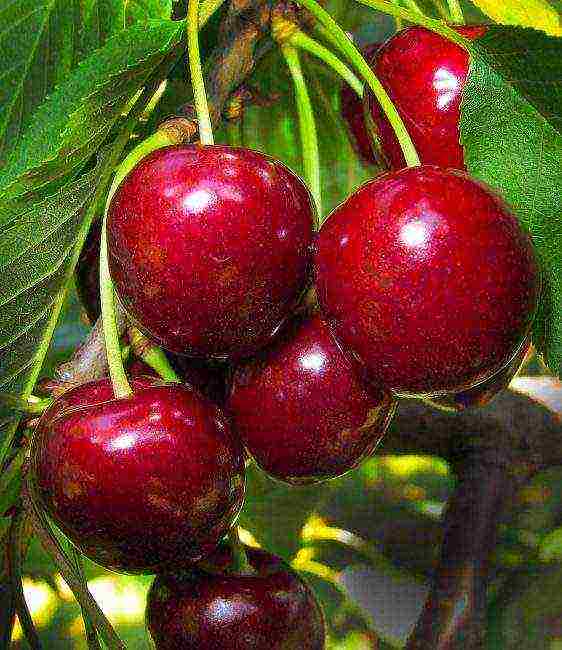
PROS:
- The crop ripens early, in the first - in the second decade of May
- The tree grows very quickly, the leafiness is medium, the crown is round
- Fruiting period begins in the fourth year after planting in a permanent place.
- The size of the fruits is quite large, 8-9 g, their color is dark red, wide-heart shaped
- The color of the pulp is dark red, the structure is medium density, very juicy, it has a sweet taste, there is a slight sourness
- The pulp separates well from the stone
- Due to the dense skin, the crop is not afraid of transportation over long distances, it retains its presentation for a long time
- The fruits can be used both for fresh use and for compotes, jams, preserves.
- Tasting score 5 points
- Dessert type harvest
- Planting material is grown from seedlings
- The indicator of resistance to fungal diseases is good
- Frost resistance is sufficient, up to - 25 degrees
MINUSES:
- Vigorous, height 5-6 m
- The yield indicator is average, up to 45 kg of fruits can be removed from one tree
Farewell
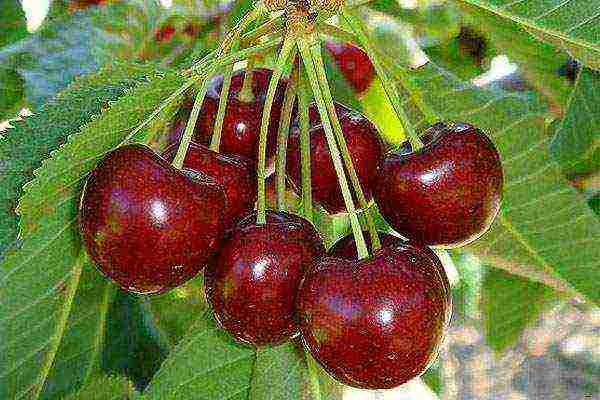
PROS:
- Sweet cherry with an early ripening period, is very popular among gardeners and consumers.
- He is appreciated for its unpretentious care.
- Excellent taste of fruits, large-fruited, high rate of drought resistance and winter hardiness
- High yield rate, up to 95 kg of harvest is removed from one tree
- Fruits are excellent for fresh use, for winter harvesting
- The size of the berries is large enough, weight up to 13 g
- The color is red, the color of the flesh is yellow
- The taste is sweet, harmonious, the aroma is pronounced, there is a wine-sweet aftertaste
- The pulp is easily separated from the bone
- The tasting score is 4.5 points
- The variety is distinguished by its early maturity
- The yield is high, after 10 years the figure is about 100 kg
- Thanks to the dense skin that protects the pulp well, the crop can be stored for a long time and is not afraid of transportation over long distances
- High degree of resistance to coccomycosis
- Increased degree of frost resistance
MINUSES:
- The tree is very vigorous, which makes it difficult to pick berries
- The variety is self-fertile, additional pollination is required.
- Average indicator of resistance to fungal infections
Pollinator varieties: Donetsk coal, Valery Chkalov, Donetsk beauty, Sister, Valeria, Donetsk Yaroslavna, Ethics, Rannnya rovinka, Aelita, Annushka, Donchanka
Yaroslavna

PROS:
- The tree is medium-sized, its height does not exceed 3.5 m
- Does not require special conditions for growing, care
- The yield indicator is high, annual
- Type of separation from the stalk dry
- Taste and marketable qualities are excellent
- Fruit size is large, weight is 8-9 g
- The pulp is very sweet, pleasant, of medium density, red in color
- The color of the cherry pomegranate is red, the stone is small in size, it separates well
- The increased degree of frost resistance, drought resistance, resistance to coccomycosis
- Berries in high humidity conditions do not crack
- Transportability is good
MINUSES:
- The variety is vigorous, the crown is spherical - spreading, the branches are curved
- Additional pollination required
- Average indicator of resistance to fungal infections
Pollinators: Ovstuzhenka, Raditsa, Iput, Chermashnaya, Fatezh.
8 Overall Score
After reviewing the description of cherry varieties, having studied their strengths and weaknesses, you can choose the most suitable option for your personal plot. It is recommended to purchase seedlings in specialized retail outlets, while you need to pay attention to the presence of damage on the trunk and root system. We tried to collect for you the most popular varieties of sweet cherries and give all the necessary information on them. If you disagree with these ratings, leave your rating in the comments with the reasoning for your choice. thank you for your participation. Your opinion will be useful to other users.
Add your review | Read reviews and comments
Review of the best varieties of cherries - according to gardeners' reviews
Sweet cherry is a sweet and aromatic southerner with early ripening. There is a high temptation to plant a slender tree on your site and feast on fruits with delicate pulp. According to the experience of gardeners in the Moscow Region, the Middle Belt and the Southern Urals, growing sweet cherries and obtaining a rich harvest is akin to art. The main problems that arise when planting a thermophilic tree in a harsh climate are associated with insufficient winter hardiness and susceptibility to diseases. It is these characteristics that you need to pay attention to when choosing the best cherry variety for the Moscow region.
Sweet cherries are self-fertile, therefore, to set fruits, a pollinator variety with the same flowering period is needed. Planting one tree is not enough. But as an alternative, you can graft a different variety into the crown of an adult tree. Sweet cherries are vigorous trees, and for normal development they are planted at a distance of 4 - 5 m. They form a powerful, deeply penetrating root system and do not tolerate close passage of groundwater. These features must be taken into account when assessing your site so that the planted trees do not have to be uprooted after a few years.
Read more about the best varieties of cherries for the Moscow region and the Middle Strip, the Urals, the southern regions in our rating, compiled according to reviews of experts and experienced gardeners.
The best varieties of cherries - Top 8
The best early varieties of cherries
|
Iput 500 (one-year-old in a container (ZKS)) Our rating of the best varieties of sweet cherries is opened by an early variety that ripens in mid-June. The tree is 4 - 6 m high. The crown is broad-pyramidal, dense. Fruits are leveled, weighing from 5 to 10 g, blunt-hearted, black-red, with dark red tender pulp of medium density, the separability of the stone is medium. The taste is juicy and sweet with sourness. Ripe fruits have an appetizing, attractive, presentation. With a lack of heat and sun, the fruits acquire a tart taste and pronounced sourness. In favorable years, 25 - 35 kg are harvested from one tree. Winter hardiness of this cherry variety is good, but in severe winters there is a slight freezing of the growth and average damage to flower buds. After returnable spring frosts, no more than 60% of the ovaries are damaged. Disease resistant. Recommended in the Central and Central Black Earth regions. In the Moscow region, Nizhny Novgorod, Penza and Samara, gardeners note good adaptive qualities. Pollinating varieties: Revna, Tyutchevka, Bryanskaya rozovaya, Ovstuzhenka and Raditsa. Main pluses:
Minuses:
|
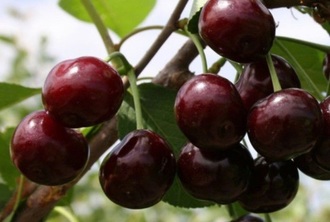 9.8 / 10 Rating Reviews Good, very early cherry variety, does not get sick. It ripens with me with garden strawberries. The fruits are large, but watery and sour.
|
|
Chermashnaya 850 (two-year-old in a container (ZKS)) Yellow-fruited sweet cherry with early ripening. The tree is 4.5 - 5 m high. The crown is spherical, raised, not thickened. Fruits are one-dimensional, even, rounded, weigh on average 4 - 4.5 g, pale yellow, with a thin and dense skin. Dessert taste, sweet with a slight sourness. The pulp is juicy and tender, yellow in color, the separation of the stone is good. Uncomfortable ripening is observed. The average yield of an adult tree is 15 - 20 kg. The variety is absolutely self-fertile, that is, it will not tie a single fruit without a pollinator. For pollination, plant Fatezh, Raditsa or Bryansk pink. Differs in early maturity: fruiting begins 3-4 years after planting. Winter hardiness of wood is at the average level, flower buds can be damaged by spring frosts. Recommended for growing in the Black Earth region. There is a positive experience of growing in the Moscow region, however, gardeners, after harsh winters, note the appearance of frost holes on the bark. Main pluses:
Minuses:
|
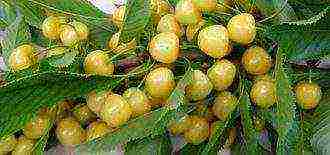 9.7 / 10 Rating Reviews Nice yellow cherry, the tree is just strewn with berries. I like the fact that when the neighboring red cherry ripens, our Chermashnaya does not attract starlings.
|
|
Ovstuzhenka 420 (one-year-old with open root system) A good variety of cherries with early fruit ripening. Trees 3 - 4 m high, with a dense, raised, spherical crown. The short stature of the trees makes harvesting easier and protects the fruit from starlings. Fruits are round, deep burgundy, weigh 4 - 7 g, the flesh is dark red. They are easily separated from the stalks, with a dry separation, the separation of the bone from the pulp is good, they do not crack. The taste is juicy and sweet, without astringency. The yield of one tree with good care and without damage is 50 - 60 kg, in the first years of fruiting - 10 - 15 kg. Partially self-fertile, therefore, even without a pollinator, it sets a small (about 5%) number of fruits. Pollinating varieties: Revna, Bryansk pink, Iput, Tyutchevka, Raditsa. Differs in high winter hardiness and frost resistance, including flower buds and ovaries.Shows high resistance to coccomycosis and moniliosis, moderately affected by clasterosporiosis. The variety is zoned in the Central region. There is a good experience of growing in Chelyabinsk and in the Central lane. Main pluses:
Minuses:
|
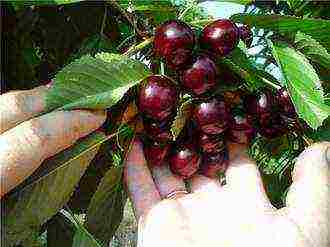 9.7 / 10 Rating Reviews In general, we are satisfied with the variety. Good classic cherry in appearance and fruit taste. It does not cause problems and is always strewn with berries.
|
The best mid-season cherry varieties
|
Fatezh 850 (two-year-old in a container (ZKS)) The fruits ripen on average, from the second decade of July. The tree grows up to 4 - 5 m. The crown is sprawling, spherical, of medium density, needs to be shaped to maintain a compact shape. The lower branches droop under the weight of the harvest. The fruits are aligned, well-rounded, weighing 3.8 - 6 g, yellow with a large red blush, with a dry separation from the stalk. The taste is juicy and sweet with a pleasant sourness. The pulp is pink, firm. The bone is easily separated from the pulp. Up to 50 kg are harvested from one adult tree, in the first years of fruiting, productivity is at the level of 10 - 30 kg. This cherry variety is recommended for cultivation in the Central region, Moscow region. Positive cultivation experience has been obtained in many areas of the Middle Belt. Chermashnaya, Revna, Ovstuzhenka, Raditsa or Iput are planted as pollinators. Main pluses:
Minuses:
|
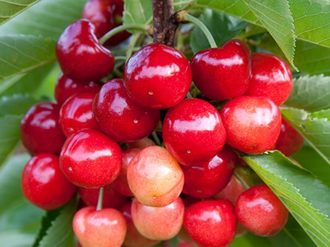 9.8 / 10 Rating Reviews The fruits are small, but the cherry harvest pleases, and even unripe fruits are quite sweet.
|
|
Gift to Stepanov 420 (one-year-old with open root system) A new medium-late sweet cherry variety of the Bryansk selection. The tree is 4 - 5 m high, with a pyramidal, sparse crown. Fruits are rich red or burgundy, weighing 3.5 - 4.5 g, aligned, blunt-hearted, with dark red, juicy, cartilaginous pulp and delicate skin. Dessert taste, estimated at 4.9 - 5 points. The peduncle comes off easily, the stone is separated well. In the description of this cherry variety, good resistance to major diseases and high winter hardiness are declared. In the State Register since 2015, zoned for the Central Region. Also, gardeners grow this cherry variety in Nizhny Novgorod and Chelyabinsk. Main pluses:
Minuses:
|
 9.7 / 10 Rating Reviews One-year cherry seedling quickly took root and started to grow, it adapts well to growing conditions.
|
The best late varieties of cherries
|
Bryansk pink 850 (two-year-old in a container (ZKS)) A versatile late-ripening cherry variety. The tree is 4 - 4.5 m high and has a slow growth rate. The crown is wide-pyramidal, raised, moderately thickened. Fruits are pink with a tan and a characteristic speck, weigh on average 4 - 5.5 g, regular rounded shape, with a dry separation, do not crack when waterlogged. The pulp is dense, yellow, with weak cartilage. Light juice. The separation of the bone from the pulp is average. The taste is juicy and sweet, with a slightly pronounced bitterness. One tree bears an average of 20 - 30 kg of fruit. Ovstuzhenka, Tyutchevka, Iput and Revna are suitable pollinators. Resistance of the trunk and skeletal branches to frost breakers is observed. High winter hardiness of wood and flower buds, sensitivity to spring frosts. High resistance to coccomycosis, moniliosis and clasterosporiosis. Recommended for cultivation in the Central region, widespread throughout the Middle zone. Main pluses:
Minuses:
|
 9.8 / 10 Rating Reviews Good cherry for the Moscow region, the fruits are smallish, but sugary-sweet. The variety is not sore and not capricious, but the yield is stable.
|
|
Jealous 730 (two-year agronomic grid) A good proven variety of late-ripening cherries. The tree is fast-growing, 4 - 5 m high, with a sparse pyramidal crown. It lends itself well to all types of shaping. Fruits are beautiful, broadly rounded, weigh from 5 to 8 g, dark red, almost blackening when ripe, with dry separation, transportable. The pulp is rich red, dense. The bone is separated well. The taste is juicy and sweet, gaining 4.8 - 5 points during tasting. The average productivity of one tree is 30 kg. The variety is partially self-fertile: without a pollinator, sets up to 5% of the potential number of fruits. Good pollinators are Ovstuzhenka, Tyutchevka, Raditsa, Iput. The stem and skeletal branches are not affected by frostbites. Shows high winter hardiness and good resistance to recurrent frost. Differs in good immunity. Zoned in the Central Region, but actively grown throughout the Middle Lane. Main pluses:
Minuses:
|
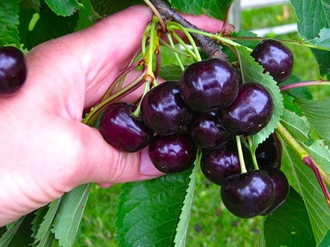 9.8 / 10 Rating Reviews A young tree is always healthy and strong, even after a harsh winter it looks better than other sweet cherries.
|
|
Tyutchevka 420 (one-year-old with open root system) Late sweet cherry, ripens at the end of July. The tree is medium-sized, 4 - 6 m high. The crown is spherical, sparse, moderately spreading. Fruits weigh from 5 to 7.4 g, rounded with a wide base, red with specks. The pulp is firm, red. The separation of the bone from the pulp is average. Fruits are transportable, with dry separation. The taste is excellent. Up to 40 kg can be harvested from one tree annually. The variety is partially self-fertile. Iput, Raditsa, Revna or Ovstuzhenka are planted for pollination. In the conditions of the Moscow region, gardeners note the cracking of berries when rainy weather is established during the ripening period. It is moderately affected by clasterosporium and coccomycosis, very rarely - by moniliosis. In severe winters, trees freeze slightly. Spring frosts during the flowering period can destroy up to 70% of the ovaries. Zoned for the Central region, successfully grown in the Middle zone and the South Urals. Main pluses:
Minuses:
|
 9.7 / 10 Rating Reviews The best cherry for the Moscow region, in my opinion. Surprises with high frost resistance. I rate the fruits at 5 points, even unripe sweet ones, and the children eat with pleasure.
|
Members of the forum also recommend cherry varieties in reviews: Rossoshanskaya rose, Bryanochka, Teremoshka, Milan, Pamyat Astakhov, Raditsa and Valery Chkalov. When choosing cherries for their site, gardeners of the Middle Lane often prefer medium-sized and winter-hardy varieties.
For cherries, as for a thermophilic culture, spring planting is desirable. They buy seedlings with unblown buds. If the leaves have opened in the warmth, then the seedling must be urgently planted in the ground in order to prevent the drying of the shoots and roots. In regions with a protracted spring, it is better to buy planting material with a closed root system: in a container, the tree will painlessly endure the wait for planting. The planting hole is prepared in the fall, and the soil mixture for backfill is stored in a closed unheated room. These measures will allow you to land at the earliest possible date.
With cherries, there are very frequent cases of re-grading, when southern varieties are passed off as zoned ones. Cherry seedlings are best bought from trusted stores, local nurseries or reputable private gardeners.
We wish you a good harvest!
Attention! The reliability of the information and the results of the ratings is subjective and does not constitute advertising.
Foreword
There are many varieties of cherries today! In the south of Russia, more thermophilic trees are grown, and for the Moscow region and regions of the middle zone, it is better to choose frost-resistant plants. How not to get confused in the variety of cherry varieties and find the best one for your garden, we will tell in this article.
The best self-fertile varieties for the Moscow region and the middle lane
Self-fertility of varieties lies in the ability of fruit trees to self-pollinate with their pollen. Self-fertile are those that form 20-40% of the total number of flowers. Self-fertile varieties do not need cross-pollination with other varieties. Their advantage is that they are independent of the flight of pollinating insects.

Self-fertile cherry
But today there are not so many self-fertile varieties of sweet cherries. Therefore, even with such trees, it is better to plant pollinating varieties near, which in any case will help to increase yields.
The best varieties of self-fertile cherries for the Moscow region today are recognized:
- Narodnaya Syubarova is considered the best option throughout Russia. True, one should not expect a huge harvest, 50 kilograms from one tree is the limit, it is no longer possible to harvest even in the most successful year. The berries of this sweet cherry are of medium size. The tree itself is tall, with a powerful trunk and branches that can withstand the load from snow or wind. The plant is highly self-pollinated, fruits ripen up to 90%. Saplings take root well and are able to grow even on sandy loam and loamy soils.
- Ovstuzhenka is a frost-resistant sweet cherry that can withstand up to -45 degrees, Conditionally self-fertile, since pollination takes place within one tree, the resulting ovaries are no more than 90%. Medium large berries, 4 to 7 grams. The yield is 30-50 kg per tree. The tree is not tall, which allows it to be grown on an industrial scale.
- Revna is a small plant with a pyramidal crown. Self-fertile, very fertile, not large-fruited, its berries are not large, but very sweet and aromatic. Cold-resistant, withstands frost down to -6 degrees during the flowering period. Possesses high transportability, shelf life for a long time, dense, not watery at the stage of maturity.
Early winter-hardy and late cherry varieties
Almost all known cherry varieties are mostly self-fertile, and only a few species are self-fertile, and then only partially, since they also require pollinator varieties for a full harvest. Therefore, when choosing a variety for planting in your garden, you need to immediately buy a pollinator plant with it in pair, which will have the same flowering period. Sweet cherry is divided into 3 groups according to flowering time.
Winter-hardy early cherry varieties:
- Iput - frost-resistant, has good fruits. Pollinators can be Revna and Raditsa.
- Household yellow - self-fertile variety, frost-resistant, vigorous, slow-fertile, quite fruitful. The berries are medium, sweet and sour.
- Gronkavaya is a strong, frost-resistant variety. The fruits received a high dessert rating. Suitable pollinators: Cheremashnaya, Raditsa, Iput, Fatezh and Ovstuzhenka.
- Red hill - less resistant to diseases, berries were highly appreciated. Pollinators, like Iput's.
- Ovstuzhenka - refers to partially self-fertile varieties, fruits with a good score. It is good to plant next to Iput cherries.
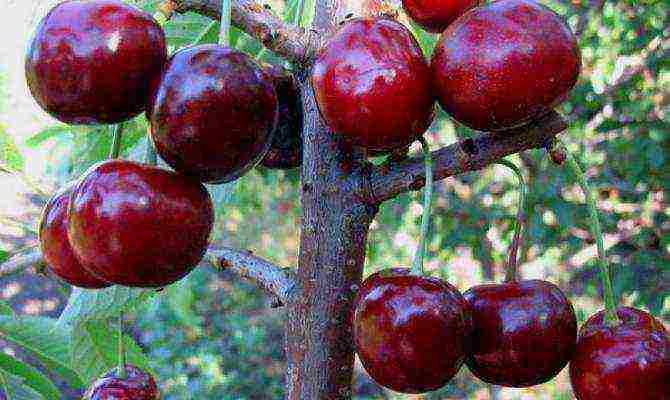
Winter-hardy cherry variety "Iput"
Mid-season cherry varieties:
- Rechitsa - belongs to the varieties of the bigarro group, frost-resistant, not large-fruited, with very sweet dark red berries. Disease resistant. From pollinators it is better to choose Pink Pearls, Adeline and Ovstuzhenka.
- Leningrad black from the guinea group. Sweet medium-sized berries, with pulp inseparable from the seeds. A tree of medium height, unstable to frost, not capable of self-pollination. Pollinators: Iput, Revna, Bryanochka, Tyutchevka and Veda.
- Leningrad pink - also belongs to the gini group. Small berries with a delicate, yellowish skin with ruddy barrels, the flesh is sweet and yellow. The plant is quite tall, has a lush crown, does not self-pollinate. It is recommended to plant next to the following varieties: Adelina, Chernyshevsky, Pink Pearl and Rechitsa.
- Tyutchevka is a medium-sized tree, very resistant to cold and disease. The berries are bright red, of medium size, well suited for freezing and transportation. The plant is partially self-pollinated. Recommended pollinators: Iput, Raditsa and Ovstuzhenka.
- Large-fruited - a tall, fast-growing tree with a broad-shaped crown of medium density. Large-fruited cherry has dark red berries, the weight of which is 10-12 grams, it is considered a dessert variety. The best pollinators will be Surprise and Oratovsky.
Late ripening varieties:
- Michurinka is not a tall tree that is resistant to drought and disease. The berries are dark red in color, strong, fleshy and sweet. Stored for a long time and well transported. The variety is self-fertile. Pollinators required: Michurinskaya late and Pink pearls.
- Bryansk pink - belongs to the bigarro group. The berries are medium-sized, about 5 grams, with sweet pink flesh that cannot be separated from the stone. For pollination, the following varieties are suitable: Iput, Revna, Ovstuzhenka and Tyutchevka.
Yellow cherries that are not afraid of birds
Red cherries, especially early varieties, are very fond of pecking birds. If the garden is located near the forest, rowan thrushes flying from it are capable of destroying the entire berry crop in a matter of hours. Therefore, it is better to cover the red-fruited varieties of the Moscow region with a net during the period of their fruiting.
The yellow cherry is not afraid of this misfortune - the birds do not touch its berries, and the harvest remains intact. In addition, red fruits do not tolerate heavy summer rains and often crack. The yellow cherry, in contrast to the red-sided cherry, has no such disadvantage.
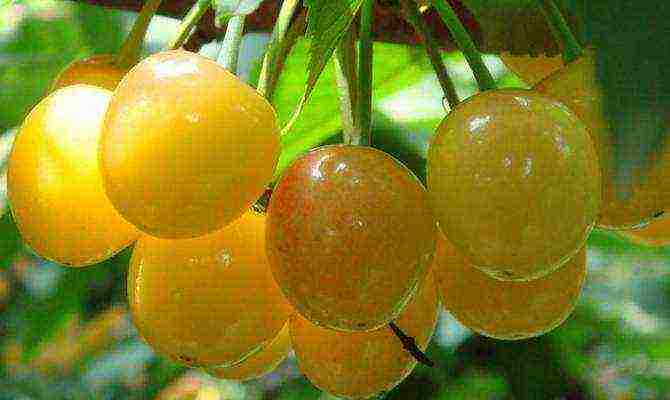
Yellow cherry
Cherry of the variety "Yellow Priusadebnaya" is most often found for the Moscow region. She is from the early maturing varieties of the bigarro group. The berries are of medium size, weighing about 5-6 grams, their pulp, like the peel, is yellow, sweet, but with a slight sourness. Yellow Household loves black soil, so it takes root well in the middle lane.
Features of the variety:
- self-pollinated tree, has high yield rates;
- fruiting begins quite late - at the 6th year, while ordinary trees begin to bear fruit in the fourth year;
- frost-resistant variety, resistant to fungal diseases, not afraid of cherry flies;
- requires frequent pruning and removal of shoots, since the tree multiplies quickly and has a very lush crown.
Low-growing trees - small, but remote
To achieve high yields on a small planting area, columnar fruit trees are increasingly used, since there is less maintenance and consumption of related materials, and mechanized harvesting is also applicable to them. Among the thousands of cultivated varieties known in the world, tall ones prevail.

Columnar fruit trees
And only a few of them, such as the yellow Fatezh cherry, have a relatively moderate growth. To breed low-growing sweet cherry varieties, modern breeders have used several methods of suppressing the dominant gene of tallness. We will tell you about two of them.
- Growing dwarf donors. Cultivated large cherries are usually grown on antipka seedlings, which are vigorous rootstocks. Low-growing rootstocks are used to reduce the height of the tree. Clonal cherry rootstocks known today have a wide range of possible crown reduction, which is 20-90%. The effectiveness of the use of low-growing rootstocks has been noted by world breeders, industrial gardeners and private farms.Thanks to the latest research, the promising use of dwarf cherry rootstocks was confirmed, which influenced the further development of breeding in this direction.
- Exposure of test specimens to radiation. This method is based on causing a mutation in plants that suppresses the dominant traits of their tall stature. As a result of the work of Canadian specialists, low-growing varieties of cherries were bred - dwarf Compact Lambert and Compact Stella. The resulting columnar forms have earlier periods of full fruiting than large-fruited tall cherries.
But, despite many advantages, even the best columnar varieties have a number of disadvantages. Flower buds of low-growing cherry rootstocks have low resistance to spring frosts, which often leads to a noticeable loss of part of the crop. In addition, the buds of dwarf trees bloom earlier than those of tall plants, which can lead to the threat of freezing.
Another significant disadvantage of the columnar sweet cherry is its over-yielding capacity, since the fruits ultimately lose significantly in size, which affects their market value. To prevent this phenomenon, the crowns of columnar trees need regular adjustments aimed at regulating the load on the crop.
Rate the article:
(1 vote, average: 4 out of 5)
If you cannot boast of a large plot, then when choosing a cherry variety for yourself, you should focus not only on its characteristics (yield, fruit weight, taste, resistance to pests and diseases), but also on its self-fertility.
Self-fertility is the ability of trees to bear fruit without cross-pollination with trees of other varieties. Self-fertile cherry varieties will have to be selected by those gardeners who own small plots and are not able to place several varieties blooming at the same time on them for mutual cross-pollination. Unfortunately, not so many varieties are capable of self-pollination.
We have selected the top 7 best self-fertile cherry varieties and ranked them in descending order of self-fertility (from the highest to the lowest value of this indicator). All these varieties will surely delight you with a decent harvest, even far from the "sister" trees.
It is important to understand that the yield of inter-pollinated cherry trees will always be higher than that of self-pollinated plants. This is a specific feature of the culture - in order to obtain the maximum yield variety declared in the description, the sweet cherry needs pollinating varieties.
Backyard yellow
This variety is the leader of our top, as it has the highest self-fertility among the known varieties of sweet cherry. Due to the fact that the size of the tree is medium, and the fruits are tasty and fragrant, the Home Garden is always a welcome guest on any, even a small garden plot.
The yellow color of the fruit will add charm and charm to the garden, decorate the table and diversify the gardener's diet. You won't have to wait long for fruits - trees quickly enter fruiting, are characterized by active growth and high resistance to both diseases and pests, as well as to winter frosts, and even spring frosts.
Sweet cherries of this variety will always provide you with a harvest, because its fruits hang on branches without crumbling or cracking even in rainy weather.
| Entering fruiting | Tree height (m) | Fruit weight (g) | Harvest | Pollinating varieties |
| For 5-6 years | 3,5-4,5 | 5,0-5,5 | Early July | Does not need pollinating varieties |
Bereket
This variety has a high self-fertility, however, to increase the yield, one or a couple of pollinator varieties can be planted with it. The variety was obtained at the very beginning of the XXI century, and therefore is characterized by all the characteristics inherent in modern varieties - high winter hardiness and drought resistance, as well as resistance to pests and diseases.
The trees of the Bereket variety are medium in size, they are suitable for any, even the most modest site. Plants quickly bear fruit and produce beautiful dark red fruits with juicy, surprisingly tasty pulp.
The undoubted advantages of the variety include the high transportability of the fruit, and the absence of the need for formative pruning of the tree, which makes it simply ideal for planting in the country.
| Entering fruiting | Tree height (m) | Fruit weight (g) | Harvest | Pollinating varieties |
| For 4-5 years | 4,8-5,3 | 5,6-6,3 | Start - mid June |
Self-fertile, but when pollinated varieties Iput and Revna the harvest increases |
Goryanka
The variety was bred in the last century, but this does not mean that it is morally obsolete. It will give odds to any, even the most modern cultivator, because its trees have restrained growth, resistance to drought and frost, as well as diseases and pests.
The fruits of this variety are quickly tied after flowering and ripen together, turning into elegant maroon "dresses" with a pleasant, juicy and very tasty pulp.
The variety is remarkable in that it gives good yields, even on the site, a single tree is planted. The fruits can be transported over long distances without damage, and the seed in the berries is small and separates very well from the pulp.
The variety is suitable for cultivation in summer cottages and small farms.
| Entering fruiting | Tree height (m) | Fruit weight (g) | Harvest | Pollinating varieties |
| For 4-5 years | 4,1-4,7 | 6,0-6,4 |
Start - |
Self-fertile, but when pollinated varieties Iput and Revna the harvest increases |
Tyutchevka
A modern cherry variety with a whole complex of useful and necessary signs for any summer resident is both sufficient self-fertility, and the modest size of the tree, and resistance to diseases, pests, frost and drought, as well as early entry into the season of fruiting and, of course, excellent taste and fruit color, which is good in compote, and fresh when they are full of sweet juice.
The fruits have a bizarre wide-rounded shape, a dark red "outfit" pleasant to the eye and surprisingly juicy, tasty red pulp.
The variety can be advised to plant on your site also because its fruits are very pleasant to collect. The thing is that their stalk is thick and rather long, and the berries themselves break away from it easily, almost without effort, and the ripe ones hang on the branches without falling, as if waiting for you.
Due to the fact that the fruits are well transported, you can easily take them from the dacha to the house.
| Entering fruiting | Tree height (m) | Fruit weight (g) | Harvest | Pollinating varieties |
| For 4-5 years | 4,0-4,3 | 5,3-7,4 | End of June - early July |
Self-fertile, but when pollinated by varieties Ovstuzhenka or Raditsa the harvest increases |
Dunn
A rare variety can boast a complete absence of flaws, Dunn is one of them. The trees stand out among others for their luxurious pyramidal crown, which practically does not thicken and requires only sanitary pruning, for its highest resistance to winter frosts and spring frosts, as well as to pests and diseases.
It is worth planting at least one seedling of the Dunn variety on your site, as soon you will get a good harvest of large and aligned, like a ruler, fruits of a pleasant dark red color. And their flesh will be juicy, tender and so pleasant to the taste that you will eat all the berries unnoticed.
| Entering fruiting | Tree height (m) | Fruit weight (g) | Harvest | Pollinating varieties |
| For 4-5 years | 4,0- 4,7 | 4,5-4,9 | Start - mid June |
Self-fertile, but when pollinated varieties Iput and Revna the harvest increases |
Dolores
A variety with a romantic name that will not leave anyone indifferent. It will come in handy for hurry gardeners who are not used to waiting for a long harvest, for those who do not want to use a stepladder to pick every last berry, and for those who wish to see healthy and luxuriantly blooming plants when they come to the dacha or return to the garden in spring.
Those with a sweet tooth will not be disappointed either - Dolores fruits have all the qualities to satisfy the taste of even the most fastidious cherry lover. Each fruit, like a fresh candy, is “packed” in a maroon wrapper and contains a small, almost invisible bone, which is hidden in a juicy, tasty and fragrant burgundy pulp with a piquant sourness, which does not spoil at all, but on the contrary, gives the taste sophistication.
The fruits are suitable for all types of processing, and the trees are suitable for planting in any, even the smallest area.
| Entering fruiting | Tree height (m) | Fruit weight (g) | Harvest | Pollinating varieties |
| For 4-5 years | 3,5-3,8 | 5,5-6,2 | Mid june | Self-fertile, but when pollinated varieties Iput and Revna the harvest increases |
Pridonskaya
This variety closes our top-7. But do not think that he does not have sufficient self-fertility to produce crops, even if you have a single tree growing on your site. It's not like that at all. Despite the partial self-fertility, the Pridonskaya cherry will supply you with a harvest in the form of very large, one-dimensional fruits of a rich bright red color with pink, slightly gristly and very juicy pulp of a pleasant, refreshing sweet and sour taste.
The variety is also valuable because its yield is stable and annual, because the flowers are not afraid of spring frosts, and the plant itself is not afraid of severe frosts and summer heat.
The variety is suitable for growing both in the country and in an average-sized garden, its trees do not require any pruning except sanitary, and no protection, because they do not get sick and are extremely rarely affected by pests.
| Entering fruiting | Tree height (m) | Fruit weight (g) | Harvest | Pollinating varieties |
| For 5-6 years | 3,8-4,5 | 5,0-6,5 | Start - mid June |
Self-fertile, but when pollinated varieties Iput and Revna the harvest increases |
We have considered the most interesting varieties of cherries that deserve the attention of both amateur gardeners and professionals. The listed varieties have all the features inherent in modern varieties and, moreover, are characterized by high self-fertility, which will allow you to grow on the site not only cherries, but also plants of other breeds. Do not forget that planting trees of self-fertile varieties, like other stone fruit crops, is best in spring.
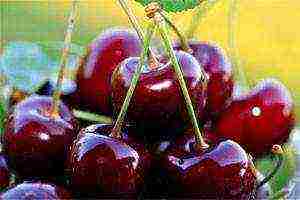
There are more than three thousand varieties of sweet cherries all over the world. Trees live and bear fruit for a long time. With good care, cherries can delight more than one generation of gardeners, there is evidence of fruit-bearing trees, whose age has reached a hundred years.
Cultivars differ in flowering time and fruit formation, frost resistance of trees, their height and crown shape. The berries have different tastes, differ in appearance: color, shape, length of the stalks.
A novice gardener who decides to plant trees on the site should consult in advance with specialists on the cultivation of the selected variety. And we will try to describe the characteristics that you should pay attention to before purchasing planting material for your site.
Tree height

Cherry variety Revna
Distinguish in height:
- vigorous;
- medium-sized;
- low-growing varieties.
An adult cherry plant is a large tree with large lateral branches and a spreading crown. In nature, cherries can grow into a 20-meter tree. A cultivated plant rarely reaches a height of 7 meters. However, this property - height and the never-ending desire to grow upward, create considerable problems for gardeners.
That is why breeders do not stop working on breeding undersized or dwarf varieties, varieties with a weeping crown. New varieties are obtained by free pollination, crossing with cherries, growing cherry-cherry hybrids.
The most famous result of this selection is the Valeria variety. For experimental purposes, young shoots are exposed to radiation. Thus, the varieties Compact Stella and Compact Lambert were obtained by Canadian scientists.
However, a low-growing plant, as a rule, tolerates cold worse, requires more careful care, and is less viable.
Take a note: at present, the most effective way to obtain dwarf, undersized and medium-sized trees is the cultivation of cherries on clonal rootstocks.
Frost resistance
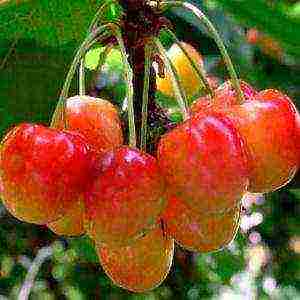
Sweet cherry varieties Francis
According to cold tolerance, trees are divided into:
- winter hardy;
- medium winter resistant;
- varieties with low winter hardiness.
It is worth remembering that sweet cherry is a thermophilic tree that naturally grows in areas with a moderately warm climate. The bark of trees is capable of withstanding frost of 20-30 degrees, but at the same time fruit buds are exposed to the danger of freezing. It is not uncommon for the buds, in which the rudiments of pistils and stamens are frozen, to retain the rudiments of petals. Therefore, after a frosty winter, flowers bloom on the branches, but they do not leave berries behind.
It is also possible to grow cherries in the gardens of the central zone of Russia. Through the efforts of breeders, winter-hardy and medium-hardy varieties have been obtained. The State Register of Breeding Achievements in the Central Region contains 14 winter-hardy species of sweet cherry. Among them, the most popular are Leningradskaya Black, Rechitsa, Chermashnaya, Iput.
But for those who want to grow this berry in the north-western regions of the country, unfortunately, there are no officially registered, verified, zoned varieties yet.
Interesting fact: there are a small number of varieties grown by amateur gardeners as an experiment. The best among them are Seda and Yurga.
Pollination
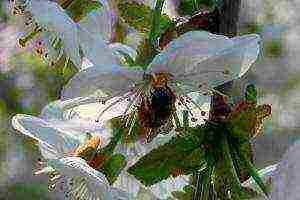
A bee pollinates a flower
According to the ability to self-pollination, it is customary to divide trees into:
- self-fertile (the most popular variety is Narodnaya Subarova);
- partially self-fertile (varieties Revna, Ovstuzhenka);
- self-infertile (Fatezh, Valery Chkalov, Chermashnaya).
A self-fertile fruit tree variety does not need other varieties of pollinators. Such trees do not depend on the number of bees and insects involved in the distribution of pollen. These are trees that can self-pollinate, or rather, in place of 20-40% of flowers, an ovary is formed, and in the future, fruits. These trees can grow on their own. Unfortunately, there are very few self-fertile cherry varieties. Or more often they belong to the partially self-fertile varieties.
In most cases, cherries are not capable of self-pollination. In order for fruits to form in place of flowers, it is necessary to plant several varieties next to each other, blooming at the same time.
Note: to improve pollination, the branches are sprayed with a sugar solution before flowering. Sugar does not affect the growth of the plant in any way, just its sweetish smell attracts bees.
However, when planting trees, "neighbors" must be selected. not all varieties are compatible. The Iput variety has proven itself as such a pollen distributor. But remember that no one cultivar is the optimal pollinator for other cultivars.
Berry ripening time

Cherry Leningradskaya black
Cherry varieties are usually divided into:
- very early. These include Early Ruby, Early Stamps. These varieties bear the first fruits by the end of May;
- early;
- early-middle;
- mid-late;
- late, which include large-fruited cherry, Raisin, Drogan yellow. Ripen in early July.
Berry color
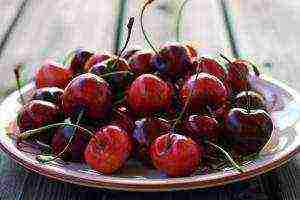
Sweet cherries of different varieties
The color of the berries can be from orange, yellow (oddly enough, this berry is often called white) to dark cherry, black.
- black cherry, more precisely, its color is dark red. An example of such a sweet cherry can be Melitopol black;
- cherry with pink fruits. The color of the berries was fixed even in the names of varieties: Leningradskaya pink, Pink pearls, Bryanskaya pink, etc .;
- yellow (white). The most common varieties of yellow (white) cherries are Chermashnaya, Drogana Yellow, Radiant light.
Fruit shape and weight

Large cherries
By fruit size, cherry cultivars are divided into:
- large - weighing more than 5 g.These include: Revna, Drogana yellow, Tyutchevka, Iput, Raditsa, Sadko;
- medium (3-5 g);
- small (up to 3 g). Berries of these varieties are more like large cherries, but they have a sweet taste. Varieties with small berries include Early pink, Leningrad pink.
The shape of the berries is usually round, but there are varieties with a heart-shaped shape that is slightly flattened on the sides.
According to the hardness of the fruit, it is customary to divide the berries into bigarro and gini. If the fruits are soft, tender, with a thin skin, which quickly leave traces of touching, pressing, light bumps against each other - you are dealing with varieties of gini. As a rule, these are berries of early maturing varieties. These trees will delight you with flowering and the first berries by the end of May, but such varieties poorly retain their presentation, are practically not transportable.
Bigarro - dense berries with cartilaginous pulp, streaked, are of great industrial value, because possibly for longer storage, adapted for transportation, widely used in conservation, production of dried fruits.
How to grow various varieties of sweet cherries on the same tree, planting it using the improved copulation method, see the following video:
Rate the article
(
estimates, average:
out of 5)
Sweet cherry is a southern culture. Previously, the middle region of our country was not suitable for growing this berry, and all because this plant did not survive in the harsh winters. Complex logistics, transportation costs, time - all this increased the cost of the final cost of the berry and made it truly "golden".
The most heart-healthy product
Today, breeders have developed many varieties that can grow in the northern regions. Yes, the yield will be less, the fruiting period is shorter, but the taste will not change from this. And how to choose cherries for the Moscow region, the best variety of which everyone determines for himself, you will learn from our article.
Choosing a fruitful cherry variety for the Moscow region
First of all, it is worth noting that this tree itself is very finicky, and even more so in conditions that do not meet the requirements of its growth. Some time ago, a large-scale destruction of cherry orchards was observed in the Moscow region, which served as the development and cultivation of new varieties of cherries. The best varieties of cherries and cherries, which can be grown in the northern regions of Russia, have not only excellent taste, but also disease resistance.
Most varieties tolerate transportation well.
The best cherry varieties for central Russia can grow fully under the following conditions:
- "Sparing" frosts;
- lack of sharp temperature changes;
- ensuring a sufficient amount of light and heat during flowering and ripening of fruits;
- timely care, cultivation and watering;
- regular fertilization of the soil.
The best varieties of cherries that can be grown in the Moscow region do not tolerate both early and late frosts in the autumn and spring seasons, at a time when the sap flow either has not yet ended or has already begun.
To increase the yield of cherries, regular fertilization of the soil is imperative. Otherwise, the fruits will be small and not juicy.
Today, every experienced gardener is already familiar with all the best varieties of sweet cherries that can be grown in the Kuban, Krasnodar and Altai Territories. Whereas inexperienced landowners will probably be interested to know what species of this plant can easily grow in cold regions.
Read with this article: Wood ash as soil fertilizer
Rating of the best varieties of sweet cherries by yield
The best varieties of cherries for the Moscow region, the forum about which allows you to find out all the details of growing this berry, have already managed to prove themselves well as the most persistent and fruitful. But at the same time, you should not completely trust the breeding data and let the cultivation of a thermophilic tree take its course.To get an excellent harvest, it is worth taking care of both the process of planting the seedling and the timely fertilization of the soil. This is the main condition for obtaining high yields.
Narodnaya Syubarova
One of the best self-fertile cherry varieties for cultivation in the northern regions is distinguished by the fact that it takes root in almost any climatic zone. The five-year-old tree has a well-developed branching system and trunk. And the crown of such a plant is strong, capable of protecting internal tissues from frost and other negatively influencing factors.
Variety Narodnaya Syubarova
Saplings of the People's Subarova cherry take root in the Crimea, Ukraine and even in the Volgograd region and have a unique resistance to coccomycosis. High-quality maturation is possible both in loamy and sandy loam soil. Such a plant belongs to the self-fertile group that does not need the help of other pollinating trees.
The large fruit has a juicy burgundy flesh, a pleasant sweet taste, while the rind is distinguished by a waxy bloom. The berry is harvested from a four-year-old seedling. Fruit weight fluctuates within 4-6 grams, and a large harvest can be obtained from a tree - up to 50 kg of fruits. This grade can be said to be "quality + quantity". The ripening period is the end of July.
Iput
Self-fertile sweet cherry, mid-season, begins to bloom in the second decade of May. But the harvest takes place in the first ten days of July. Decorate any garden with its beautiful and voluminous deciduous system. The fruits are burgundy, rarely dark pink. And if the site is well fertilized, then they can have a practical black color. The frost resistance of this tree is extremely high.
Variety "Iput"
The berry is large, the weight of which can reach 6 grams. But in order to grow this type of plant, you need to adhere to all the rules and techniques of agrotechnical care for it. The tree is not pollinated, so it is extremely important during the period of ovary formation to make every effort to lure insects onto it. This is the only way to get a high yield.
Ovstuzhenka
The best cherry variety for the Moscow region, reviews of which are only positive. This is due to the high level of cold resistance - the plant is able to withstand frosts down to -45 ° C. Due to the fact that the height of the tree is no more than 2.5 meters, it is most often planted on an industrial scale.
Ovstuzhenka
The berries are dark red and can weigh up to 6 grams. Begins to bear fruit in the fourth year of growth. Up to 25 kg of fruit can be harvested from a tree. This species, which can withstand persistent frosts, is very popular among both experienced gardeners and beginners. Tyutchevka, Ipun, etc. are suitable for pollination.
Cheryomashnaya
This is a southern hybrid species, the height of the trees of which reaches 5 meters. The berries are yellow, medium-sized and oval in shape. In sultry heat, the fruits can be with a pink barrel. Due to its good winter hardiness, this species is able to grow in the Moscow region and adjacent regions. A distinctive feature of Cheremashnaya is its high resistance to various fungal infections. Pollinating varieties - Ipun, Valery Chkalov, Priusadebnaya yellow, etc.
Cheryomashnaya
Description of the species: fruiting begins in the fifth year of ripening. The weight of one berry reaches 4.5 grams, and up to 27 kg of fruits can be harvested from one tree.
Jealous
The plant has a pyramidal form of development of the deciduous system. For the most part, this variety decorates "home" gardens. The tree bears many fruits, and, despite its small size, they are distinguished by excellent taste and unique aroma. During the flowering period, the fruit seedling is able to withstand minor frosts - up to -7 ° С.
Jealous
Distinctive feature:
- long shelf life;
- high resistance to fungal infections.
The berry has a maroon color, juicy and firm. The beginning of fruiting occurs in the fourth year of growth.The crop is ready to be harvested in the first decade of July.
Tyutchevka
Differs in high fruiting. The fruits are maroon, and sometimes even black. Distinctive feature:
- long peduncle;
- good transportability;
- long shelf life;
- large berry sizes - up to 7 grams;
- pleasant, tasty aroma and honey taste;
- self-pollination.
Backyard yellow
A tall seedling that grows up to four meters over three years. The berries are large, slightly elongated and bright yellow in color. A type of early ripening period, it is able to maintain resistance to prolonged frost. Differs in good productivity and resistance to typical diseases of fruit trees.
Backyard yellow
The beginning of fruiting occurs in the sixth year of ripening. Whereas the first sweet cherries can be harvested in the second decade of July. The weight of the berry is up to 6 grams, and up to 60 kg of the crop can be harvested from one tree.
Now you know which cherry varieties are better to plant in the Moscow region. We hope these tips will help you make the right choice and grow beautiful and fruitful fruit trees in your garden.
Cow heart
A worthy example of the best cherry varieties for the Crimea. One of the largest, juicy, aromatic berries. Early flowering - May-June. Ripens in the middle of summer. Begins to bear fruit 5 years after planting the seedling. The yield is very high - an average of 100 kg per tree.
Cow heart
The variety is frost-resistant, not susceptible to attack by insects and fungi. Requires fertile soil and deep soil. It can die within a month if the root starts to rub against hard rocks.
VIDEO: The best varieties of cherries

Foreword
Until now, it is not possible to take more than 5-10 kg from one tree, while all the fruits are not larger than peas? Why not plant large-fruited and high-yielding cherry varieties for a temperate climate and change this situation for the better?
The sweetest and most delicious options according to the estimates of experienced Russian gardeners
For many lovers, size is not the main thing in fruits, as their taste is valued first of all. Over the past 15 years, more than 80 varieties have been bred with a sugar content of more than 5%, which is a very good indicator for such fruits. They immediately gained great popularity among summer residents and began to spread not only across the territory of Russia, but also to other countries. We would like to bring to your attention the brightest representatives of this class.
- Sweet cherry Julia. It is a very tasty fruit that should grow in every summer resident who loves to feast on sweets. 5.9% sugar, more than 2% ascorbic acid make it extremely tasty and healthy. The pulp is firm, slightly crispy. For many years of cultivation on the territory of Russia, it has established itself as a reliable, proven, constantly fruitful option. Unfortunately, it will not work to collect a large number of berries, but you can count on 15-20 kg from one adult tree, and both in a productive year and not very much. The crown is not spreading, the branches are directed upwards, do not hang down, which significantly complicates the harvest in the middle of summer. Late cherry (medium late), has excellent resistance to pests, as well as to diseases, only 1 treatment with pesticides from caterpillars is required throughout the season.
- Sweet cherry Yaroslavna. If you want to grow a really tasty fruit at home or in the country, Yaroslavna is the best fit for this. The average sugar content is up to 14.2%, which is a record for domestic breeding options... It is a worthy competitor to European trees, since, in addition to everything else, it gives up to 60 kg from one tree. That is why it has become the choice of many gardeners, farmers who are seriously engaged in the cultivation of products for sale and export.Keeping quality is very good, does not crack when ripe, tolerates prolonged rains, can be on the tree after technical ripening for a couple of weeks. All late varieties of sweet cherry cannot be compared with it in this category, for which it has earned such popularity in Russia.
- Cherry Ostozhenka is another representative of the "tasty" category. It contains up to 13% sugars, at the stage of technical ripeness it has an unsurpassed taste, perfect for canning, preparing desserts, dishes, selling on the market (has excellent keeping quality) or just for eating raw. This is where its advantages, perhaps, end. The disadvantages include low yield (collection of 25 kg from one tree can already be considered a record), its weak resistance to frost (up to -20C), as well as weak biological protection against pests. It requires careful care, otherwise it will bear little fruit.
The above options are not for nothing that they are so popular. They not only give tasty berries, but have excellent resistance to pests, tolerate cold winters, temperature changes, which cannot be said about large-fruited options. The load on the branches is small, it is easy to form a crown, they grow with minimal maintenance, and they constantly give average yields.
The largest-fruited trees, their characteristics
If you want to grow fruits with an excellent presentation and sell them at a higher price, then you need to pay attention to the following description of sweet cherry varieties. They do not have any supernatural taste, their yield is average or slightly above average, but the weight of the fruits is much higher than ordinary berries. Here are some alphabetical descriptions of the "heavyweights".
- Sweet cherry Bull heart. One of the largest-fruited, the weight of one berry can reach 8 grams, which is an unprecedented result for 90% of all results of domestic selection, foreign selection. The crown has a pyramidal appearance, and the natural neglect is small. The only negative is that the fruits crack when ripe, especially if the wet weather outside alternates with a dry, hot wind. Excellent taste, slight sourness. Has a dark color, excellent presentation. Poorly transported, keeping quality is low, winter hardiness is high, easily tolerates frosts down to -25 degrees.
- Dyber black cherry. Fruiting only for 5 years of growth, but immediately gives 7-9 kg from one plant. At 11 years old, it bears fruit in full and you can collect up to 60 kg from one tree, due to this, the yield per hectare reaches 90 centners. One of the biggest advantages of this tree is the size of the fruit - the average weight reaches 6.6 grams, which is a lot for this type of fruit. Sweet, up to 12% sugar, at the stage of technical ripeness has a black color, as well as a characteristic odor, which is much stronger than usual. It is in great demand in the market, as it has an excellent presentation, is well transported and lasts for several weeks. Does not crack in normal weather, but some fruits may crack during rain if the fruit is ripe. Daibera surpasses the best varieties of cherries of European selection, especially in terms of fruit weight. This is a “must have” of every summer resident!
- Italian. It is difficult to imagine early varieties of sweet cherries without this bright representative, whose fruit weight is 6.8 grams, with some fruits having 8 grams. A worthy competitor to the best Dutch varieties, which is very popular in Russia, Belarus, Kazakhstan and Iran. It is grown in a temperate climatic zone and hotter regions, does not require a large amount of water and fertilizers, and gives stable, albeit small, yields. Up to 80 kg / ha can be harvested even in drought and lean years. That is why it is recommended for industrial cultivation.The resistance to pests is excellent, although the keeping quality of fruits leaves much to be desired - in a few weeks they rot and are poorly transported at the stage of technical ripeness.
Large-fruited varieties have, as a rule, low resistance to insect pests and do not tolerate sudden changes in temperature. They are noticeably weaker and difficult to take root, so if you are going to breed them and want to surprise your neighbors with huge fruits, you will have to sweat. All specimens begin to bear fruit in the 4th year, sometimes earlier you can get several berries "per tooth".
Highest yielding varieties in alphabetical order
For you, the main thing is a large yield and a solid profit from one tree? Then this category of trees is right for you. Up to 15-30 tons can be harvested from 1 hectare, while record harvests are harvested in Iran (55 t / ha). The following varieties give up to 50-60 kg per tree, due to which they are the best options for the subsequent sale of products to the market or to wholesale outlets.
- Cherry Ovstuzhenka. An unusual fruit from the point of view of many gardeners is black cherry, and its shape is cone-shaped. One of its main advantages is high yield - up to 115 centners average and 250 centners maximum. With good care and abundant watering, it can easily yield up to 50 kg per tree, and this is far from the limit. The sugar content is 11%, which also makes it one of the sweetest and tastiest in the Russian Federation and other neighboring countries. The crown is spreading, wide, the branches bend down under the weight of the fruit, in some cases supports are required, since they break off in a strong wind - this is perhaps the only disadvantage of this variety. Average frost resistance - withstands up to -25 degrees throughout the winter.
- Cherry variety Revna. Very recognizable on the territory of Russia, it has a light skin and dense flesh. Due to its yield up to 30 t / ha, it has become one of the best options for domestic farmers. Cherry Revna, reviews of which you can hear from every gardener, perfectly tolerates frosts, even at -5 degrees in April, the color does not fall off, therefore it is recommended for growing in colder regions than the temperate climatic zone. The crown is spreading, the tree grows tall, so it is recommended to pinch the top to form a suitable option for industrial use. Growing the Revna variety, you will always have cherries, even in the "leanest" year, since the stability of fruiting is greater than that of other varieties.
- Cherry Fatezh. Quite an interesting specimen, which was bred quite recently. Annual seedlings grow straight up, forming a crown in the form of a peak, after which they bend over and hang down to the ground for the next 4-5 years, thereby significantly increasing the convenience of harvesting. It gives up to 60 kg from a 10-year-old tree, for which it received very high marks from many gardeners who grow it. High winter hardiness and indifference to sudden temperature changes in spring made it number 1 among high-yielding options. It needs to be grown only next to other trees for high-quality pollination. Early cherry, ripens in early June or even late May, depending on the temperature of the year.
Foreign varieties are not recommended to be grown in our temperate latitude. They require increased attention, are whimsical to droughts and do not tolerate frosts well. It is best to give preference to Russian selection, since the plants are maximally acclimatized in our growing conditions and maximally resistant to insect pests.
Rate the article:
(4 votes, average: 4.8 out of 5)
